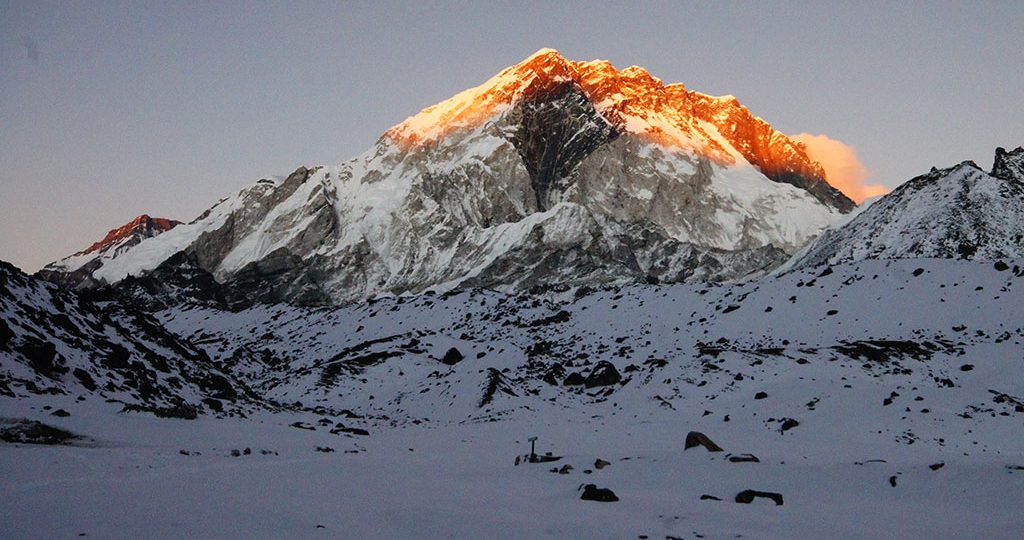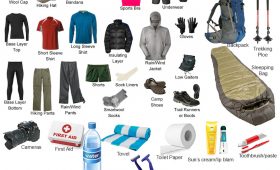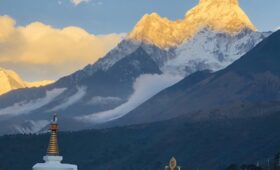You might have heard of stories of thousands of people of who trek to the Everest Base Camp each year. That might get you excited to complete the Everest Base Camp trek as well. But then you might ask yourself a very important question, “How difficult is the Everest Base Camp trek?”
No trek to the Base Camps of mountains is easy. You have to walk for a number of days. And generally, the walks are uphill. In addition to that, you should also consider the high altitude that you will go to. And these are not the only things to consider.
The trekking options are available for various months. If it rains too heavily, your trek might be slippery. If the weather is too cold, you might find it difficult to adjust to the cold climatic conditions.
And if you have not had appropriate training or if you don’t bring the right gear, you will find your problems increasing. So from altitude to your preparation, there are various things that determine how difficult your trek to the Everest Base Camp is going to be.
What Makes the Everest Base Camp Trek Difficult?
-
Altitude
Mt. Everest is unbelievably tall. It stands at a height of 8848 meters. But if you want to trek in the Everest region, you won’t have to go that high.
To set off to the Everest Base Camp trek, you have to take a flight from Kathmandu to Lukla. Kathmandu is approximately 1,400 meters above the sea-level while the Lukla airport has an elevation twice that of Kathmandu.
While trekking you will visit various places such as Namche Bazaar, Tengboche, Kala Pathar etc. Namche Bazar, known as the capital of Sherpas, is located at an altitude of 3400 meters. Along your trek, you will spend a day in this region to get used to the altitude.
Tengboche is a place where you will get a chance to experience the culture in the Everest region and will also go to Tengboche Monastery. This monastery will help you experience the rich Tibetan Buddhism that is prevalent in this region. It is located at an altitude of 3,860 meters.
The Everest Base Camp is 5,365 meters above the sea-level. Kala Pathar, the region that gives you the most splendid view of the Everest, is located at a height of 5,555 meters.
Now that you know high you will be traveling to the Everest Base Camp, you would also want to know the temperature profile as well as the weather of this region. Nepal is a country that has four seasons. And this applies to the Everest region as well The Everest region has a summer season that combines with the monsoon, winter, spring and autumn season.
Everest Base Camp Trek in Summer
The summer (June to August) in the Everest region is hot and wet. The sun shines with all its might and the daytime temperature in some parts along the trek can reach up to 25-degree centigrade. The winters are a lot more comforting and the temperature rarely goes below zero. Degrees.
However, this is also the monsoon season in Everest meaning that you have to be careful with your trekking gear as you will need to bring trekking boots that provide you a good grip.
Everest Base Camp Trek in Spring
The spring (late February to May) give you ideal time to trek to the Everest Base Camp. The amount of rainfall is minimum and the daytime, as well as nighttime temperature, is mild. The average daytime temperature in this season is 16 degrees and the average nighttime temperature is 2 degrees
Everest Base Camp Trek in Autumn
Autumn (September to November) has properties quite similar to spring and therefore has glorious trekking conditions. So, it shouldn’t come as a surprise that it is a season which is flooded by trekkers. Average daytime temperature is 15 degrees and the average nighttime temperature is -5 degrees.
Everest Base Camp Trek in Winter
Winter in the Everest (December to late February) region is extremely cold. But if you manage to keep it at bay with proper gearing, you’ll get the best possible view of the mountains as the chances of cloud covering is at a minimum. It can get as cold as -15 degrees in this season.
-
Length of the Trek
The number of days it takes for you to trek to the Everest Base Camp can be completed. And this depends upon how many days you want to spend in the Everest region.
The longest trek to the Everest Base Camp begins in Jiri. It lasts for 26 days. Other long treks to the Everest region is the Everest Base Camp trek with Island Peak Climbing and Everest Three Pass trek.
The Gokyo Valley trek is another option that you have in case the longer treks discussed above seem too difficult for you to undertake. The Gokyo valley trek will last two weeks long.
And if that seems too difficult for you, you can try out the Heli trek, which is a combination of a few days of trekking in the Everest region (Phakding, Thame and Namche Bazaar) and a helicopter flight to the Everest Base Camp.
And if you find this to be too difficult, you can fly to the Everest Base Camp from Kathmandu itself. Isn’t that wonderful?
-
Training
Training for the Everest Base Camp is what will prepare you for a joyous trekking Everest Base Camp. But the training will have to be rigorous and will have to be undertaken for at least a few months.
Training is the best measure to keep fatigue, muscle strains as well as altitude sickness that you might encounter at the Everest region away. In addition to the training, you also have to have a balanced diet and proper rest for strengthening your body.
You will have to carry your backpack and that means that there will some strain on your shoulders. And for walking close to two weeks means that you have to design your training to develop your shoulder, thigh as well as core strength.
You should also develop the habit of drinking plenty of water as well as eating food that is rich in protein, carbohydrate and fibers. This will also help you replenish the energy that you might lose while trekking.
F
General Everest Base Camp Trek FAQs
Should I hire a guide/porter?
Absolutely yes! Guide will take you to your destination in the best trails available making sure that your safety comes first. The guide are well-spoken and familiar with the English language. Some guides are multilingual and fluent in various languages.
Porters help you shed the load that you will have to carry along your treks. You can also hire a porter cum guides too!! The guide will give you a lot of relief if you get injured while trekking.
Besides, hiring a guide or a porter will also help improve the economy of the people in the region as most people here are involved in the tourism industry.
Do I need travel insurance before hiking to Everest Base Camp?
Travel insurance is the best way to make sure that in case of petty thefts or flight delays or altitude sickness, you will be insured and that your expenditure in those cases will not be magnified.
If you have to charter a helicopter for medical treatment in the Everest region, it might cost you anywhere 5000 US$ to 10,000 US$. Also, if you have to buy all your gear while trekking in the Everest region, it will cost you close to 2000 US$.
Travel insurance is a very measure to take to counter theft, cancellation of flights, and the problems of altitude sickness you might encounter. You can get a 30-day travel insurance for around 150 US$. Check with your travel company to see what things are covered by the insurance.
Have there been any deaths while trekking to the Everest Base Camp region?
There is no denying that if you don’t take good care of yourself, death is a possibility in the Everest Base Camp region. If the altitude sickness is not treated properly, the consequences might be severe, but the deaths are far too low. And it is often the case of negligence when it comes to having proper treatment of altitude sickness.
Conclusion
The Everest Base Camp trek is not as difficult as some people make it sound. With modern technology and the best trekking equipment and gear, the number of people who trek in the Everest Base Camp region is only increasing.
Also, the development of the tourism industry has facilitated easier treks in the Everest region. But that doesn’t mean you don’t pay attention to your preparation. As long as you keep the things discussed above in mind, you’ll complete trekking in the Everest Base Camp region.
Do you have any question about trip to Nepal?
Tell us about your trip to Nepal and what you expect from it. We will answer your questions in 24 hours and help you design a trip with a comfortable itinerary to best meet your needs.





